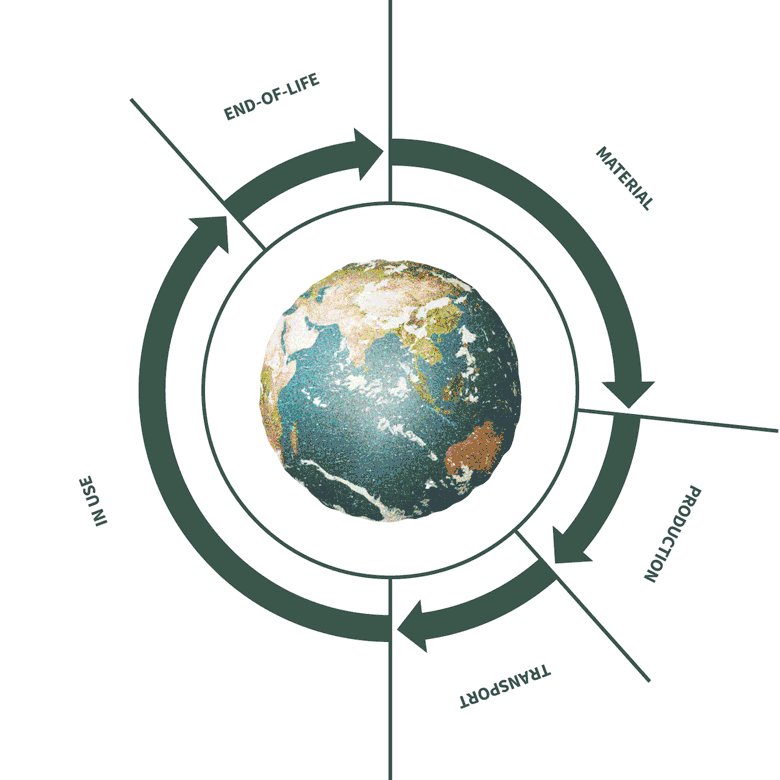Life cycle assessment
Life cycle assessment (LCA) is a method for calculating environmental impact during a product's entire life cycle – from natural resources being extracted until the product is no longer used and ready for recycling. The increased awareness of environmental and sustainability issues has led to a greater demand for climate declarations and LCA calculations.
Here you can see the climate impact from some of the analyses we have carried out on our products. We have simplified the results by dividing the life cycle into five phases. We perform our calculations in accordance with ISO 14040 and 14044.
Material Production Transport In use End-of-life
~25% <1% <1% ~75% <1%
We know that in the future, the choice of materials will be of even greater importance than today. That's why we at Fagerhult are focusing on innovative, renewable or recycled materials in our product development as an alternative to using traditional virgin and fossil materials. Our goal is for our luminaires to consist of 80% renewable or recycled materials by 2030.
Although the environmental impact of our luminaires in the production phase is already relatively low, we are constantly working on improvements and developments to further reduce it. We run our production with 100% renewable energy, including in the form of locally produced electricity from solar cells on our factory roof. We also always try to recycle materials in our own operations as much as possible, instead of incinerating them for energy.
The measured values apply to an average luminaire manufactured in our factory and production unit in Fagerhult, Habo.
Our environmental impact from transports is very low. One explanation for this is that we are close to our customers and mostly deliver by lorry, which do not produce especially high emissions in relation to other forms of transport. Our products are also sent directly to the location where they are to be installed, which means fewer trips and minimising environmental impact even more.
The greatest environmental impact that our luminaires produce is when they are in use by our customers. One way of reducing energy consumption, and thus environmental impact, is to choose luminaires with light control and constant luminous flux (CLO). Users can also rethink their choice of energy, and choose renewable electricity from solar, wind or hydropower.
The calculation for usage is based on a Swedish electricity mix and without lighting control.
Even if we love our luminaires, we understand that they cannot live forever. We know this. That at some point they will be dropped in the recycling bin. This is why we don’t glue components together when assembling our products. Everything is screwed or clicked into place. This makes it easy to disassemble the luminaires and separate the different materials so that they can be easily recycled.

Pure materials
We only produce luminaires with LEDs and have a wide range of lighting control devices, together providing the most energy-efficient solutions on the market. In step with more efficient solutions and cleaner electricity, we know that materials will play a more crucial role in the climate impact of our products. Our analyses show that materials already play a major role, just over 25%, but for a customer who only uses fossil-free electricity, the materials account for about 85% of a luminaire's climate impact.
We need a new way of looking at both our supply of resources and components in the manufacturing industry. Using virgin materials or fossil substances is not a long-term solution. We need to switch to renewable and recycled resources and materials. An example of this is our innovative product Multilume Re: Think – made of a completely new material for the industry, solid board.
Environmental product declaration
An environmental product declaration (EPD) is a standardised document that provides transparent, assured and comparable information about the environmental impact of a product during its life cycle. All our EPDs are prepared according to ISO 14025, making them comparable with other EPDs. All are audited by an independent third-party that ensures transparency in documenting environmental impact throughout a product’s life cycle. The goal is for all of Fagerhult's newly developed luminaires to have an environmental product declaration. You will find the EPDs that are currently available under Downloads, via the product filter, or on the respective product pages.
Contact us and we can talk about your next project
We know that challenges and needs differ depending on who you are and the phase of the project you are working in. Our insights into the planning process make it easier for you to get it right.